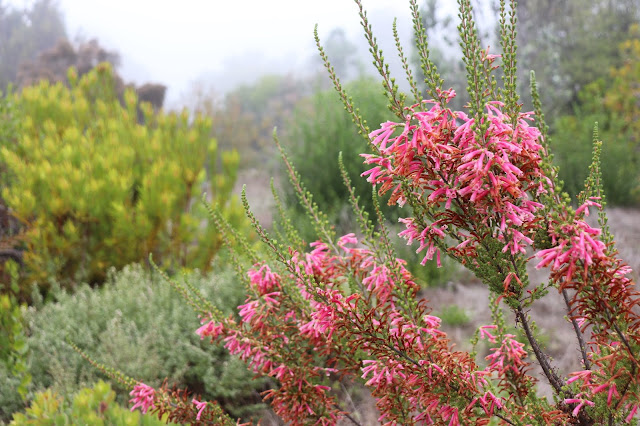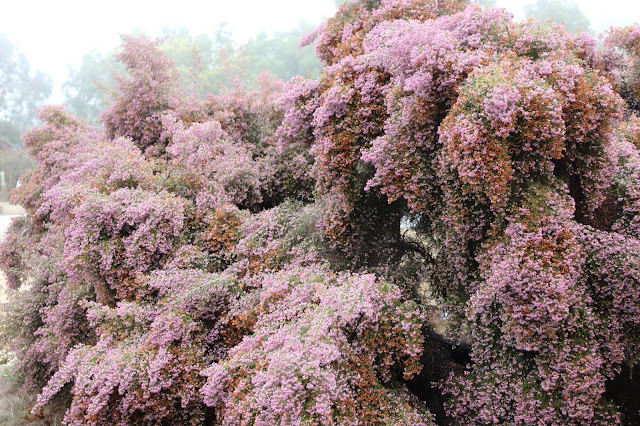Let's Go! The UC Santa Cruz Botanic Garden, Part III, South African Garden
Part III of my December visit to the UCSC Arboretum/Botanic Garden puts us in the South African Garden. Admittedly, I know very little about South African plants, but I appreciate them. I really enjoy members of the Proteaceae family. If I could grow them, believe me, I would. Heaths, members of the Erica genus I do grow and appreciate.
Come. Let's see what the gardens offered in dreary December.
Come. Let's see what the gardens offered in dreary December.
Erica discolor - the color of this one was quite noticeable from a distance.
Foliage makes the garden this time of the year, many plants just aren't blooming in December.
Leucadendron salignum 'Winter Red'
Protea nitida
Protea repens 'Rubens'
Encephalartos ferox or Zululand cycad.
Chrysanthemoides monilifera or Bietou or bush tick-berry.
Leucadendron 'Duet' - the two-toned look of this (perhaps the reason for its name) was quite bright on a foggy coastal day in Santa Cruz.
A wider shot of the same gigantic plant.
Leucadendron sessile
Leucadendron argenteum or silver tree.
Silver tree leaves
Foliage diversity
A cluster of what I'm guessing is Puya with their ghostly old flowers.
Erica canaliculata
Erica discolor
Erica gilva or green heather
From the UC Santa Cruz website on Erica:
The Garden's South African Garden is also home to one of the largest collections of members of the genus Erica (or Cape heaths) outside South Africa, where a staggering 605 species occur in an area not much larger than Santa Cruz County. The Garden's Erica collection illustrates magnificently the huge diversity of color and form found in these shrubs. The peak flowering times are later Winter/early Spring and mid-Summer.
From the UC Santa Cruz website on Erica:
The Garden's South African Garden is also home to one of the largest collections of members of the genus Erica (or Cape heaths) outside South Africa, where a staggering 605 species occur in an area not much larger than Santa Cruz County. The Garden's Erica collection illustrates magnificently the huge diversity of color and form found in these shrubs. The peak flowering times are later Winter/early Spring and mid-Summer.
Dodonaea viscosa subsp. angustifolia or giant hop bush
Cussonia paniuclata or mountain cabbage tree
Elegia elephantina
Perhaps Rhodocoma gigantea.
Leucadendron galpinii or hairless conebush (female)
A wider shot of the hairless conebush.
Prumnopitys andina or lleuque
Aulax pallasia or needle leaf feather bush
Metrosideros angustifolia or lance-leaf myrtle
Leucadendron saligna or spreading bush.
One of many spots to stop, sit, take it all in and smile.
Again, the arboretum and botanic garden at the University of California Santa Cruz (or any botanic garden) is so worthwhile to visit, support and enjoy. I hope you have enjoyed a small glimpse into the beauty and diversity of South African flora.
To read my other posts about the gardens, you can see them here and here. Other garden bloggers have visited this world-class garden and blogged about it, you can read Gerhard of Succulents and More post here and Hoover Boo from Piece of Eden here. Both visited at different times of the year to give you a more well-rounded visual experience.
To read my other posts about the gardens, you can see them here and here. Other garden bloggers have visited this world-class garden and blogged about it, you can read Gerhard of Succulents and More post here and Hoover Boo from Piece of Eden here. Both visited at different times of the year to give you a more well-rounded visual experience.
That's a wrap for this week at Chickadee Gardens. As always, thank you for reading and commenting. It is great to know there are people out there who love plants as much as we do. Happy gardening (virtual or otherwise), seed-starting and general appreciation of plants, even in February.
































.JPG)






Wow, so many interesting shapes and textures - thanks for sharing!
ReplyDeleteThanks for visiting and commenting. Such textures, indeed. I love the variations in foliage shape/texture/color.
DeleteI'm lucky that Leucadendron, Leucospermum and other South African plants will grow in my part of the country but my success in doing so only makes me want to see what the UCSC Arboretum has even more. I've yet to try an Erica...
ReplyDeleteYou ARE lucky, Kris!! I am very envious of the cool plants you can and do grow with such skill. If you get the opportunity, a visit north is so worth it. The Ericas are great because they are winter bloomers and super easy (for me, anyhow).
DeleteYour post makes me want to jump in the car right now! I have major heath envy as well. Santa Cruz is the perfect climate for so many plants....
ReplyDeleteDo it! I'd love to see more photos....Santa Cruz is pretty perfect, I agree. Thanks for your great posts on the gardens at UCSC, Gerhard.
DeleteI so wish Leucadendron was hardy here. Gorgeous photos.
ReplyDeleteWouldn't that be dreamy?
DeleteI was fortunate to visit South Africa last October (their spring), and the fynbos (leucodendrons, proteas, ericas) were in bloom all over the southern coast! We visited Kirstenbosch Botanical Garden in Cape Town … truly a special place. The trip of a lifetime! I so wish we could grow them in rainy Seattle.
ReplyDeleteWow, how lucky! Wonderful...definitely a trip of a lifetime. Thanks for sharing! Oh, if we could only grow them in the PNW.
DeleteI remember so many of the Protia when we had our Fling in SF. It was a totally new plant to me. Ericas are so finicky here in the warmer humid South. Great post, love seeing so many new (to me) plants.
ReplyDeleteProtias are pretty weird and cool - great for bouquets, too. Too bad about Ericas but you have a lot of other fab plants that we can't grow. I guess we can't grow them all!
DeleteI love this garden and some of my favorite photos have been taken here. So many great collections and no crowds .
ReplyDeleteAh, cool! Yes, there were no crowds for us, too - I thought it was because we were there in December. It's big enough to accommodate large groups, though. Such a gem.
DeleteTheir Erica collection is awesome. I've grown a couple and they've been easy, despite the non-acidic soil here.
ReplyDeleteIt is so awesome! Good to know they do well for you!
DeleteBeautiful! It took me so long to get to this post because I wanted to be sure to have the time to savor every photo. They did not disappoint.
ReplyDeleteThank you, Danger! Glad you enjoyed it!
Delete